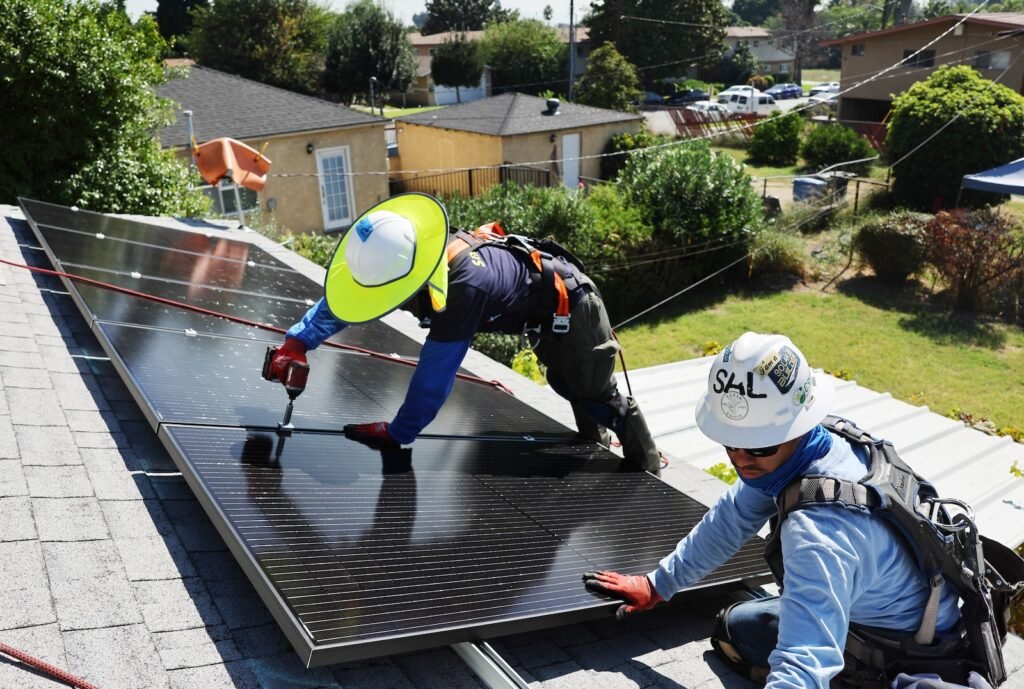Every month you pay an electricity bill, because there’s no choice if you want to keep the lights on. The power flows in one direction. But soon, utilities might desperately need something from you: electricity.
A system increasingly loaded with wind and solar will require customers to send power back into the system. If the traditional grid centralized generation at power plants, experts believe the system of tomorrow will be more distributed, with power coming from what they call the “grid edge” — household batteries, electric cars, and other gadgets whose relationship with the grid has been one way. More people, for example, are installing solar panels on their roofs backed up with home batteries. When electricity demand increases, a utility can draw power from those homes as a vast network of backup energy.
The big question is how to choreograph that electrical ballet — millions of different devices at the grid edge, owned by millions of different customers, that all need to talk to the utility’s systems. To address that problem, a team of researchers from several universities and national labs developed an algorithm for running a “local electricity market,” in which ratepayers would be compensated for allowing their devices to provide backup power to a utility. Their paper, recently published in the Proceedings of the National Academy of Sciences, described how the algorithm could coordinate so many sources of power — and then put the system to the test. “When you have numbers of that magnitude, then it becomes very difficult for one centralized entity to keep tabs on everything that’s going on,” said Anu Annaswamy, a senior research scientist at the Massachusetts Institute of Technology and the paper’s co-author. “Things need to become more distributed, and that is something the local electricity market can facilitate.”
At the moment, utilities respond to a surge in demand for electricity by spinning up more generation at power plants running on fossil fuels. But they can’t necessarily do that with renewables, since the sun might not be shining, or the wind blowing. So as grids increasingly depend on clean energy, they’re getting more flexible: Giant banks of lithium-ion batteries, for instance, can store that juice for later use.
Yet grids will need even more flexibility in the event of a cyberattack or outage. If a hacker compromises a brand of smart thermostat to increase the load on a bunch of AC units at once, that could crash the grid by driving demand above available supply. With this sort of local electricity market imagined in the paper, a utility would call on other batteries in the network to boost supply, stabilizing the grid. At the same time, electric water heaters and heat pumps for climate control could wind down, reducing demand. “In that sense, there’s not necessarily a fundamental difference between a battery and a smart device like a water heater, in terms of being able to provide the support to the grid,” said Jan Kleissl, director of the Center for Energy Research at the University of California, San Diego, who wasn’t involved in the new research.
Along with this demand reduction, drawing power from devices along the grid edge would provide additional support. In testing out cyberattack scenarios and sustained inclement weather that reduces solar energy, the researchers found that the algorithm was able to restabilize the grid every time. The algorithm also provides a way to set the rates paid to households for their participation. That would depend on a number of factors such as time of day, location of the household, and the overall demand. “Consumers who provide flexibility are explicitly being compensated for that, rather than just people doing it voluntarily,” said Vineet J. Nair, a Ph.D. student at MIT and lead author of the paper. “That kind of compensation is a way to incentivize customers.”
Utilities are already experimenting with these sorts of compensation programs, though on a much smaller scale. Electric buses in Oakland, California, for instance, are sending energy back to the grid when they’re not ferrying kids around. Utilities are also contracting with households to use their large home batteries, like Tesla’s Powerwall, as virtual power plants.
Building such systems is relatively easy, because homes with all their heat pumps and batteries are already hooked into the system, said Anna Lafoyiannis, senior team lead for transmission operations and planning at the Electric Power Research Institute, a nonprofit in Palo Alto, California. By contrast, connecting a solar and battery farm to the grid takes years of planning, permitting, and construction. “Distributed resources can be deployed really quickly on the grid,” she said. “When I look at flexibility, the time scale matters.”
All these energy sources at the grid edge, combined with large battery farms operated by the utility, are dismantling the myth that renewables aren’t reliable enough to provide power on their own. One day, you might even get paid to help bury that myth for good.

